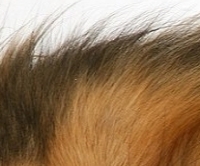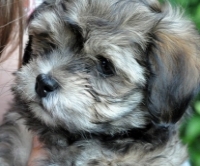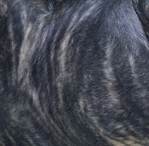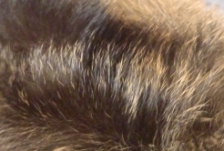
POINTS OF CONFUSION - Sable vs Brindle
SABLE
A Sable coat may appear dark at birth. As the puppy grows, the undercoat develops in a lighter colour leaving the darker shading as tipping or as a dark overlay. By even just a few weeks of age, the undercoat is very noticeably lighter. At one extreme, a dark shaded sable may appear quite dark, because he has extensive sabling all over. At the other extreme, sabling can be so sparse that the dog appears almost to be monochrome light colour with only some black fringing around the ears.
There are many variations in sable colouring. The undercoat can be assorted shades of cream, champagne, gold or red. Sables can appear light or dark depending on the amount of dark overlay or tipping. If you lift the coat, a sable is light underneath. Sable is one of the most changeable Havanese colours. The colour may soften almost to the base color as years go by. Dark tipping, if cut off, may not return. A sable will generally retain some dark hairs in the ears, tail or along the spine.


Heavy sabling Sparse sabling Dark tipping Sable puppy face
BRINDLE
A brindle dog displays a pattern of dark specks or streaks on a lighter base coat. Streaks or stripes can be soft and indistinct or sharp and well defined. Before the coat grows out, such a puppy would have markings like a brindle Boston Terrier or Great Dane.
Brindle striping becomes indistinct as the coat grows out but it is very obvious on a young puppy under two months of age. In the striped areas, the dark colour goes right to the skin. In a full long coat, brindle can appear somewhat streaky. When the coat is clipped, the pattern will reappear although may be softer and less distinct than it was as a puppy. See Hercules in Gallery 16



Brindle(heavy) Brindle(moderate) Indistinct streaks(growing coat) Brindle striping (clipped coat)
INDIVIDUAL DARK HAIRS
Both Sable and Brindle coats may have some individual black hairs mixed in to the light coat. Dark hairs are generally found on dorsal areas of the dog. This is also consistent with both patterns in other breeds. Having individual dark hairs is not a clear determining factor between Sable and Brindle.
MASK
The presence or absence of a mask is also not a decisive element. Both Sables and Brindles may have a mask. Whether they do or not is dependent on the E gene where [ E m ] gives a mask and [ E ] does not. A mask, if present, can range from a simple darkened muzzle to a raccoon-type mask to a full dark face extending into the ears. A dark dorsal stripe is common and some masked dogs also have a dark tail and dark paws. See next page for Mask Photos.